Best Water Friendly Bonsais
Make sure you don’t miss any article in our Office Executive Series:
1. Best bonsai plants for the office
2. Best small bonsais for windowsills
3. What succulents can you grow as bonsais?
4. Best water-friendly bonsais (you are here) 🌳
5. Bonsai linked to better office productivity
6. How bonsai helps with focus and goals
7. Bonsai wedding gift for your colleague
Welcome to the fourth chapter in our Office Executive Series. Today, we’re going to cover the best water friendly bonsais for your work environment.
These bonsai trees are ideal if you spend a lot of time away from your office and you’re not always available to water them. They’ll survive a few days with dry soil, but you’ll still need to care for them eventually. If you’re going to be away for a long time, either take them home or ask a colleague to care for them.

Here’s a quick look at the elements we’ll cover in this article:
Here’s a quick look at the elements we’ll cover in this article:
How Long Can A Bonsai Go Without Water?
We know how stressful life can be, at the office and at home. If you’re a beginner, it’s easy to forget to water your bonsais. It’s also challenging if you attend meetings or travel to other countries on business. For these reasons, it’s a good idea to buy water friendly bonsais.
However, it doesn’t mean they can go without water indefinitely. There are many hardy species that don’t mind some neglect, living without water for about two weeks. You’ll also find some trees that are used to drought conditions and can survive for up to three weeks.
It affects their health adversely, and you may not be able to bring it back to life if it’s too far gone. We will provide some tips in our article below, but it’s best if you don’t leave them without moisture for too long. The summer heat can be a killer.
Of course, the winter season is a different story. The bonsai will go dormant and not drink as much as it normally would. You can get away with watering once a week, and the species mentioned below might be able to survive without it for longer.
The Top Water Friendly Bonsais
With a better understanding of how long these miniature trees can go without this precious liquid, it’s time to discuss the best water friendly bonsais. The first half of this section deals with specific categories, showing you a few examples among them. Then, we’ll discuss a few specific species you should cast your eye on.
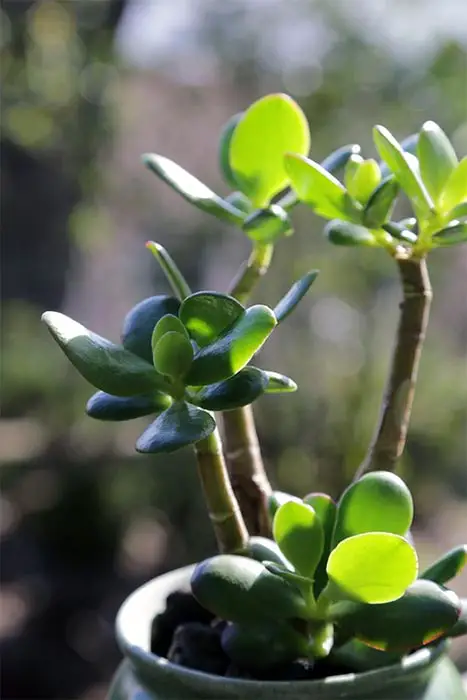
Succulent Bonsais
If you’ve been following our Office Executive series in order, you would have read our previous article, What Succulents Can You Grow As Bonsais? As such, we don’t need to go into too much detail here except to explain why they’re ideal when you’re low on water or being conservative in the office.
Succulents are popular for not needing too much water, as they store it in their trunks for the long term. You can bathe the pot and soil in water for about 30 minutes, and then leave the bonsai to stand for a few days. Even in the summer, it should take a good two to three days before the soil feels dry, and then you can wait another two days on top of that.
Of course, regions with excessive heat may cause the tree to be thirstier, but your office environment will probably be cool inside. Here are some species from that list:
- Jade Plant (Portulacaria afra)
- Jade Bonsai (Crassula sarcocaulis)
- Gollum Jade Bonsai (Crassula ovata ‘Gollum’)
- Crown of Thorns (Euphorbia milii)
- Poinsettia (Euphorbia pulcherrima)
Hydroponic Bonsais
In our article on different types of bonsais, we had a specific section for hydroponic bonsais. One of the top benefits of this system is that it captures and then reuses the water solution. In effect, the liquid can last you about two to three weeks before you need to replace it.
As you can tell, this method is the most effective way to conserve water at the office and not waste any of it. Of course, there are only some bonsai species that will thrive in these conditions. We’ll highlight them here again:
- Scots Pine (Pinus sylvestris)
- Japanese Red Maple (Acer palmatum)
- Maidenhair (Ginkgo biloba)
- Fukien Tea (Ehretia microphylla)
- Geraldton Wax (Chamelaucium uncinatum)
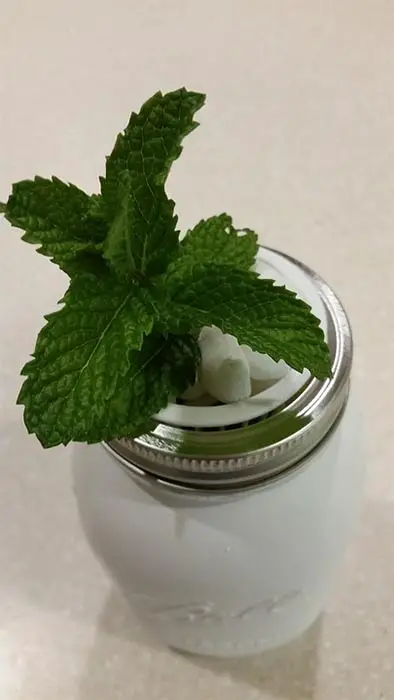

Drought-Resistant Species
If you’re living in dry regions like Arizona, you may already be familiar with some tree species that are used to drought conditions. They’ve built such a resistance while staying in these environments that you can easily grow them as bonsai without worrying about watering regularly.
While we’ll list a few of them, all you need to do is search for species that thrive in desert areas of the world. Any of them will be suitable as water friendly bonsais. If you place them in a shady space in your office, they’ll need even less liquid in the summer. You’ll be happy to know that most of them are also resistant to frost due to how cold deserts become in the winter.
- Peeling Plane (Ochna pulchra)
- Wild Laburnum (Calpurnia aurea)
- Wild Pear (Dombeya rotundifolia)
- Camel Thorn (Acacia erioloba)
- Monkey Thorn (Acacia galpinii)
- Coast Silver Oak (Brachylaena discolor)
- Carob Tree (Ceratonia siliqua)
Drought-Resistant Species
If you’re living in dry regions like Arizona, you may already be familiar with some tree species that are used to drought conditions. They’ve built such a resistance while staying in these environments that you can easily grow them as bonsai without worrying about watering regularly.
While we’ll list a few of them, all you need to do is search for species that thrive in desert areas of the world. Any of them will be suitable as water friendly bonsais. If you place them in a shady space in your office, they’ll need even less liquid in the summer. You’ll be happy to know that most of them are also resistant to frost due to how cold deserts become in the winter.
- Peeling Plane (Ochna pulchra)
- Wild Laburnum (Calpurnia aurea)
- Wild Pear (Dombeya rotundifolia)
- Camel Thorn (Acacia erioloba)
- Monkey Thorn (Acacia galpinii)
- Coast Silver Oak (Brachylaena discolor)
- Carob Tree (Ceratonia siliqua)
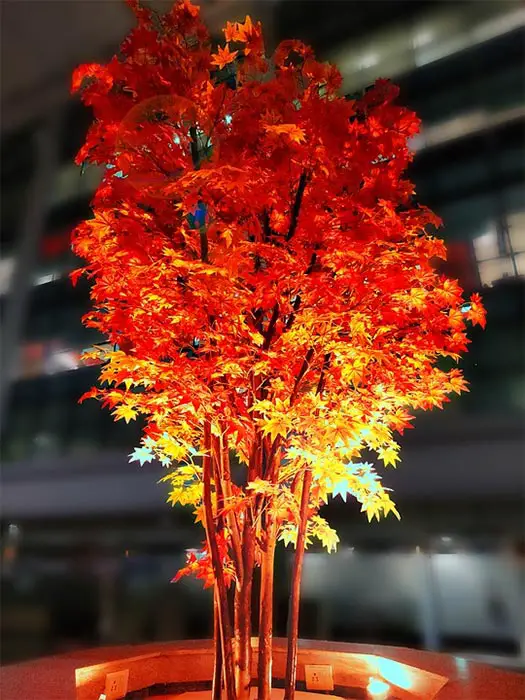
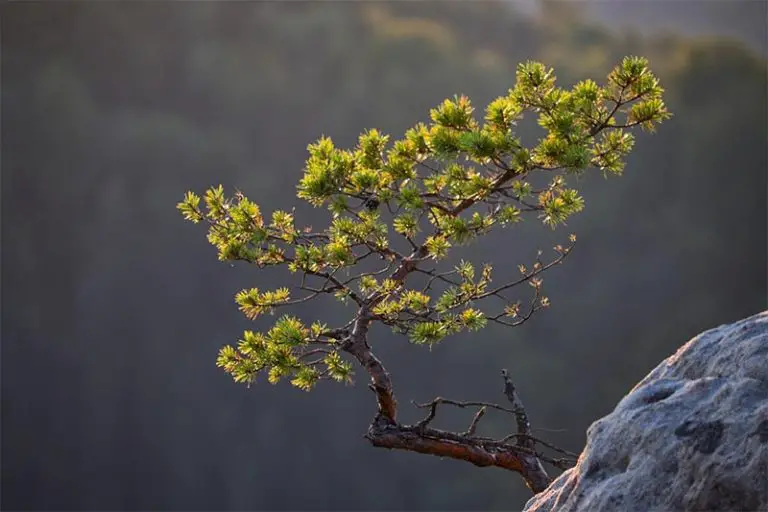
Rockery Bonsais
If you love creating rocky landscapes, there are some you can grow that don’t need loads of water. Most of these develop into shrubs instead of full-blown trees in the wild, but they still present gorgeous scenery. You can create small or large designs, but it all depends on how much space you have.
We recommend rockery trees if you have a courtyard at work where you can place them. They can become messy at times, especially if someone knocks them over at your desk. Here are some water friendly bonsais that are known for doing well in rock formations:
- Hinoki Cypress (Chamaecyparis obtusa)
- Tropical boxwood (Neea buxifolia)
- Blue Atlas Cedar (Cedrus atlantica)
- Blue Palo Verde (Parkinsonia florida)
Austrian Black Pine (Pinus nigra)
We now turn our attention to specific water friendly bonsais that are beautiful to grow. First up is the Austrian Black Pine, native to European countries. Not only can it handle light watering, but the tree can live to over 100 years old. The pine branches have a bottlebrush appearance, and you can easily use it as a small Christmas tree on your office desk.
The bark has a yellow-brown color that can become grey as it grows older. You might even see small ‘fissures’ as it matures when the bark starts to scale. The leaves can become irregular in shape at times, so you’ll need to perform some design pruning when this happens.
If you claim a young bonsai, you may need to water more than usual in the first year. After that, it will gladly go a few days without it. Watch out for incredibly old trees, as they are prone to pests and diseases.
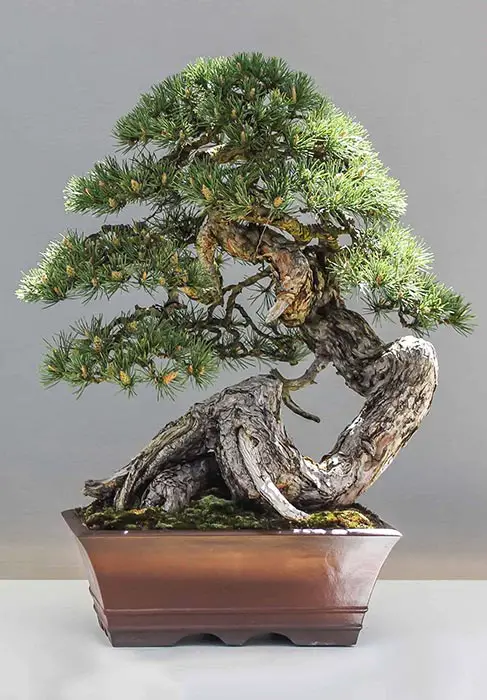

Image courtesy of 3.0 Unported.
Chinese Pistache (Pistacia chinensis)
This exceptional tree belongs to the cashew family and is native to China. It loves partial shade and full sun, so you can place it anywhere in your office where it can receive indirect or direct light. The choice you make will determine how much you’ll need to water it.
One striking feature of this water friendly bonsai is the orange leaves in autumn. It will make your desk flare with color and will draw attention from your colleagues. In summer, it has bright green leaves, and you may see flowers and fruit if the conditions are right.
While the Chinese Pistache is fond of soaked soil now and again, it can withstand hard, drought conditions. As a matter of fact, it can go a week without water even when it’s warm. However, we don’t recommend it, and you should check the soil or water tray to see when it needs more.
Cape Holly (Ilex mitis)
The Cape Holly is a tree that’s indigenous to South Africa, but it has many sister species worldwide. Despite bearing delicious berries, it’s evergreen in nature instead of deciduous. You’ll see green leaves all year round, which gives the office a lively touch in winter.
In spring, it bears small white flowers that produce a wonderful scent. Since it’s dioecious in nature, you can find female and male versions of the species. The fruit and flowers put on a stunning display, which might attract butterflies and birds to your courtyard.
The tree is used to dry conditions in the field, so it can manage without water for a few days. Of the utmost importance is preparing it for winter dormancy in the last few months of autumn. You’ll reduce the watering schedule and temperature in your office so that it can start becoming used to the cold conditions.
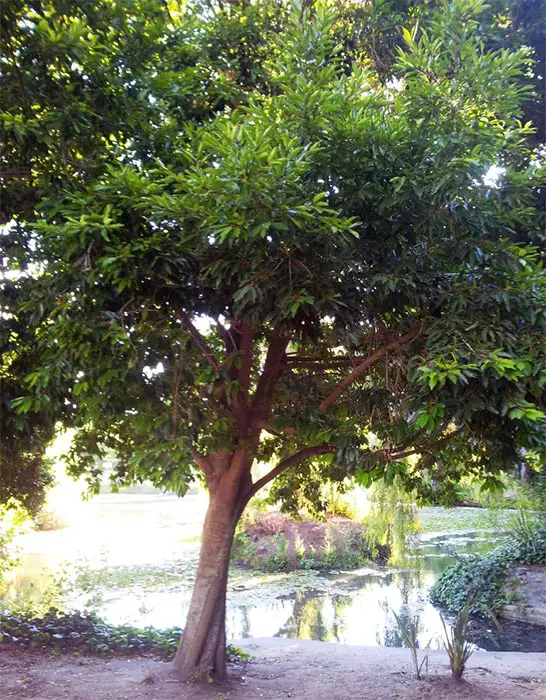
Image courtesy of 3.0 Unported.

Image courtesy of 4.0 International.
Weeping Boer-bean (Schotia brachypetala)
This gorgeous tree is often used as an ornamental bonsai, for the home and office. It loves hard conditions, and it can thrive even in poor soil. Most plant stores sell Boer-bean seeds since they are so easy to propagate. We recommend trying to grow one at your desk from a seed.
Of course, the pride and joy are the flowers if you want to buy a mature bonsai tree. It has red flowers that contain so much nectar that it often drips from them. It’s for this reason that people refer to the tree as weeping.
The woodland tree is used to living in arid regions where there’s little water. Even during droughts, it’s one of the hardwood trees that survive without a drop of liquid for days on end. If you want water friendly bonsais that can live without too much care, the Weeping Boer-bean is one of your top selections.
Tree Wisteria (Bolusanthus speciosus)
The Tree Wisteria bonsai is prized for its stunning foliage throughout summer. Classified as a creeper, it forms part of the legume/bean family with the Weeping Boer-bean. The hardwood tree has drooping branches, which is one of the reasons people love growing this tree.
Another reason is the spectacular lilac flowers that dangle from the foliage in clusters. However, you may wait 10 years before you see the first blooms, and that’s if the conditions are correct. It also needs delicate pruning after flowering to maintain its health and protect it from becoming top-heavy.
While we’re referring to it as one of the water friendly bonsais, this species needs some attention. You’ll need to use a water tray to test how thirsty it is. The tree can survive dry conditions in the wild, but it may be different in your office as a bonsai. It also depends on how much shade you provide. Always water from the tray, while soaking the soil once a month in summer.

Image courtesy of 4.0 International.
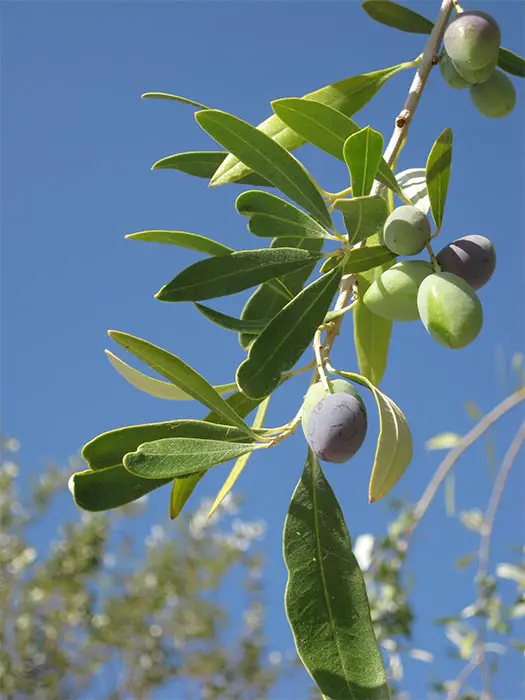
Olive (Olea europaea)
With its own olive family of trees, the European Olive is the species mostly selected as one of the top water friends bonsais. It’s native to many countries in the world, namely, South and North America, South Africa, New Zealand, and Australia. Finding one of these to grow in your office shouldn’t be challenging to achieve.
It has evergreen silver-green leaves that won’t change color in winter, while its natural shortness makes it ideal as a bonsai. In most cases, the branches twist in an unseemly fashion, but it’s perfect for incredible ramifications. The white flowers are feathery and tend to grow on older branches instead of new ones.
The main reason the olive tree does so well as a bonsai in dry conditions is that it doesn’t like its roots wet for too long. You’ll have a better time leaving the soil until you feel it’s completely dry to the touch, and then watering the next day. However, your office environment may have too much sun or heat, so pay special attention to the health of the leaves.
Sweet Thorn (Vachellia Karroo)
Also known as Acacia Karroo, this shrub is grown by many as a bonsai, especially in Africa. It has a massive list of common names from many countries, but Sweet Thorn is by far the most popular. If you want a water friend bonsai that loves to show off its colors, you’ll need to get your hands on this one.
The eye-candy of this tree is the bright yellow flowers that look like pom-poms. It has a red bark, which contains large white thorns up every branch. As it’s a low-growing shrub found in the grasslands, it’s easy to maintain it as a bonsai.
Thanks to its ability to live in arid regions, you won’t have any trouble with watering. You can leave it in the bright sun on your desk, and it will gladly go a few days without liquid. If you want healthy leaves and flowers, you can place a tray under the pot to judge when to water again.
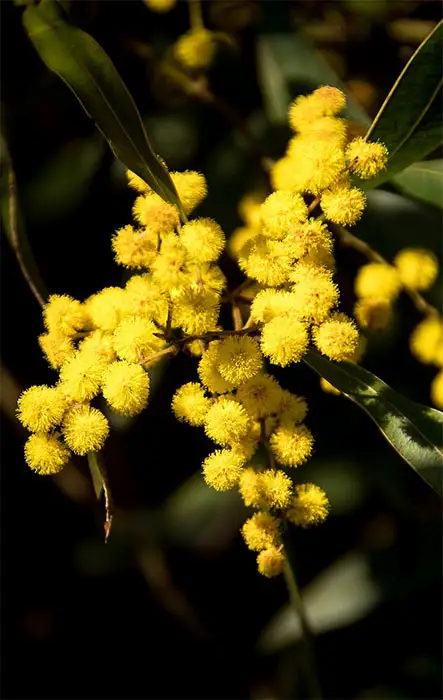
Watering Guidelines for Office Bonsais
Even though these water friendly bonsais can live for several days or weeks without moisture, there are still some aspects you need to keep in mind. Remember, not everyone has the same indoor conditions, and they don’t always respond the same way.
Always Check Moisture Levels Anyway
While we’ve mentioned that some species can go weeks without water, it doesn’t mean you should neglect your bonsai. Do yourself a favor and check how dry the soil is. You can use your finger or chopsticks to feel the top three inches of soil. There are also some slow-releasing watering devices you can use.
Use a Tray if You’re Unsure
The best way to provide liquid to water friendly bonsais in your office is via trays. The trees will drink from it when it wants to, and you can monitor the frequency. Don’t worry if the tray is dry for a day or two, as it will give the roots time to dry before the next drink.
Giving it a Bath
Some of the species we mentioned enjoy having a soak now and again. You can place it in a tub or bucket for an hour or more, which will then saturate the soil. If done correctly, you won’t need to water for the next few days or even a week. You can feel the soil now and again to check.
Misting or Spraying
While the bonsai trees may not need loads of water in the soil, they still need high humidity. Unless you have an air conditioner or humidifier that increases moisture in the air, you may need to mist the leaves daily. We know it can be tricky doing it in the office, so you may want to take it outside for a walk.
Office Environment Plays a Vital Role
If you have a species we mentioned, and you see it’s incredibly thirsty compared to what we said, the reason could be your office environment. Some trees draw nitrogen from the surrounding air or soil, which may be lacking in your space. Also, air ventilation and conditioning have an impact on how thirsty your tree becomes.

Planning for Your Vacation Days
When you’re going away from your office on vacation, you’ll need to make some plans for your bonsai. You have some options you can consider, but you don’t want to come back to a dead tree. Here are some final tips before we end this guide.
- Educate your colleague: Sometimes it helps to chat with a colleague who also has a passion for plants. They’ll understand the need to care for your bonsai and will love doing so. All you need to do is teach them how regularly to water your tree and keep in touch with them while you’re gone.
- Consider taking it with you: Not everyone can afford a luxury holiday. Most people spend their short vacations at home, which is when you can take your bonsai with you. However, some bonsais don’t like changing locations, so check the species guide first.
- Provide a water checklist: If you have someone looking after your bonsai while you’re on holiday, ensure there’s a water checklist on your desk. In that way, you can monitor how much water was provided in your absence.
- Call a friend: There are times where calling a close colleague or friend may do the trick if you’re out of the country. You can check who’s readily available to quickly moisten the soil for you.
- Include it in the watering plan: Some companies have office plants throughout the building that a janitor or contractor waters daily. It doesn’t hurt to see if they’ll add your bonsai to the program while you’re gone.
Final Thoughts
As you can see, there are many species you can grow as water friendly bonsais. While they can live under harsh conditions, it always hurts us to see a tree struggle without proper bonsai care. If you’re really in a position where you can’t nurture it every day, ask a colleague to share the responsibility with you.







